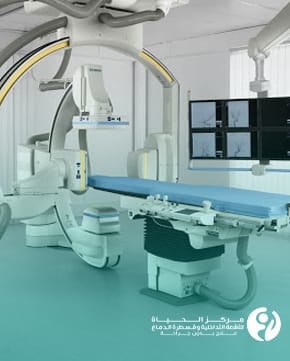
At Al Hayat Center for Interventional Radiology, we are always keen to receive your inquiries and questions. In this article, we address the most frequently asked questions about interventional radiology, a cutting-edge medical technology that has transformed the methods for diagnosing and treating diseases.
What is Interventional Radiology?
Interventional radiology is a therapeutic technique that relies on accurate diagnosis and non-invasive intervention to treat diseases. Body systems are imaged with ultrasound, magnetic resonance imaging, computed tomography, and other technologies to diagnose conditions such as arterial blockages, tumors, or deformities. These methods help in identifying, locating, accessing, and taking biopsy for further analysis.
Additionally, treatment can involve injections via an arterial or intravenous catheter or cauterization using medical microwave radiation or thermal radiofrequency.
Clot treatment involves administering clot-dissolving agents locally via a catheter after pinpointing the clot's location. In the case of tumors, chemotherapy is targeted directly at the tumor site to reduce its size. In cases of atherosclerosis, stents are inserted through catheters that widen the artery to ensure easy blood flow and prevent the formation of clots.
What does interventional radiology treat?
Brain diseases:
- Brain blood clots.
- Brain hemangioma.
- Brain tumors.
- Atherosclerosis.
Reproductive system diseases:
- Enlarged prostate gland.
- Varicocele.
- Uterine fibroid tumors.
Diseases of the digestive system:
- Esophageal varices.
- Bile duct obstruction.
- Urinary tract diseases.
- Renal artery stenosis.
- Pelvic congestion syndrome.
- Stones.
- Ureteral obstruction.
And many other diseases, such as glandular diseases, varicose veins, etc.
Procedures before undergoing interventional radiology:
- Anticoagulants or other glandular medications may be stopped before the scan.
- Notify your doctor if you have prosthetic devices, joint replacement, or subcutaneous implants, as they may interfere with the interventional radiology procedure.
- Fasting hours depend on the type of procedure.
- The removal of prescription lenses and any jewelry or metal.
- Ensure that vital signs such as temperature and pulse are stable. In case of having a cold, for example, the doctor should be informed, as the procedure may need to be postponed.
What are the advantages and disadvantages of interventional radiology?
The advantages of interventional radiology are that it is the most accurate, as the veins, arteries, and organs of the body are imaged with high accuracy, which helps in rapid diagnosis. The patient avoids many consequences resulting from common diagnostic errors that cost a lot of effort and money and consume the time available to treat critical diseases.
Among the diseases that require rapid life-saving intervention are brain blood clots, which must be treated in no more than 4 hours, as well as brain hemorrhages, spinal cord injuries, and advanced oncological diseases, as interventional radiology has made a breakthrough in the treatment of these critical conditions.
The success of interventional radiology in treating serious diseases:
In addition to safety, interventional radiology is a non-invasive procedure, so the complications of surgery and the risk of infection are non-existent. Compared to conventional treatments, interventional radiology saves the patient a lot of hassle of the surgical side effects. The procedure is completely painless, which encourages the patient to take a step towards treatment, unlike other treatments, which may pose a psychological burden that affects the patient's decision to receive treatment and adhere to it.
Regarding potential disadvantages, risks such as bleeding, infection, and minor pain at the catheter insertion site can be minimized through ongoing medical monitoring at reputable centers. Additionally, performing medical tests that ensure that the patient can safely receive the dye dose reduces the risks.
As for radiation doses and their impact on the body's health, patients' safety is ensured by referring to scientific literature that guarantees the proper practice of interventional radiology.
Otherwise, interventional radiology is the best option in terms of cost, safety, and ease of procedure.
Interventional Radiology at the Al Hayat Center in Iraq:
Who are we?
Al Hayat Center for Interventional Radiology and Neurointervention is the first integrated center in Iraq and the Arab world, specializing in providing high-quality healthcare to patients who require advanced and precise interventional medical procedures. At Al Hayat Center, we treat thousands of patients yearly through a distinguished medical team and advanced medical equipment.
As far as patients are concerned, we have several values ensuring that every patient receives the best medical care, including:
Personalized care: We focus on placing patients at the center of our attention and are dedicated to offering individualized and tailored care for each person who seeks our services.
Dedication and professionalism: We work with great commitment and care to achieve the highest levels of professionalism in all aspects of our work, whether in diagnosis, treatment, or communication with patients.
Innovation and development: We strive to constantly enhance and advance our services by utilizing cutting-edge technology and the latest equipment to achieve optimal results.
Integrity and ethics: We adhere to the highest standards of integrity and ethics in healthcare, treating patients with honesty and transparency.
Respect and empathy: We respect, empathize, and treat everyone with compassion, ensuring a comfortable and encouraging environment for patients and their families.

